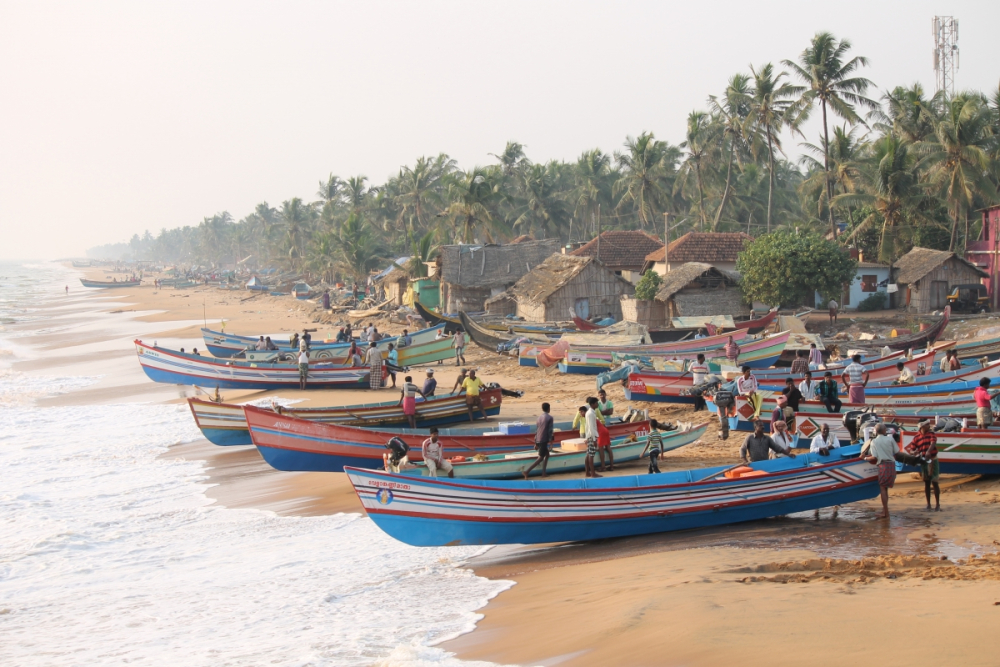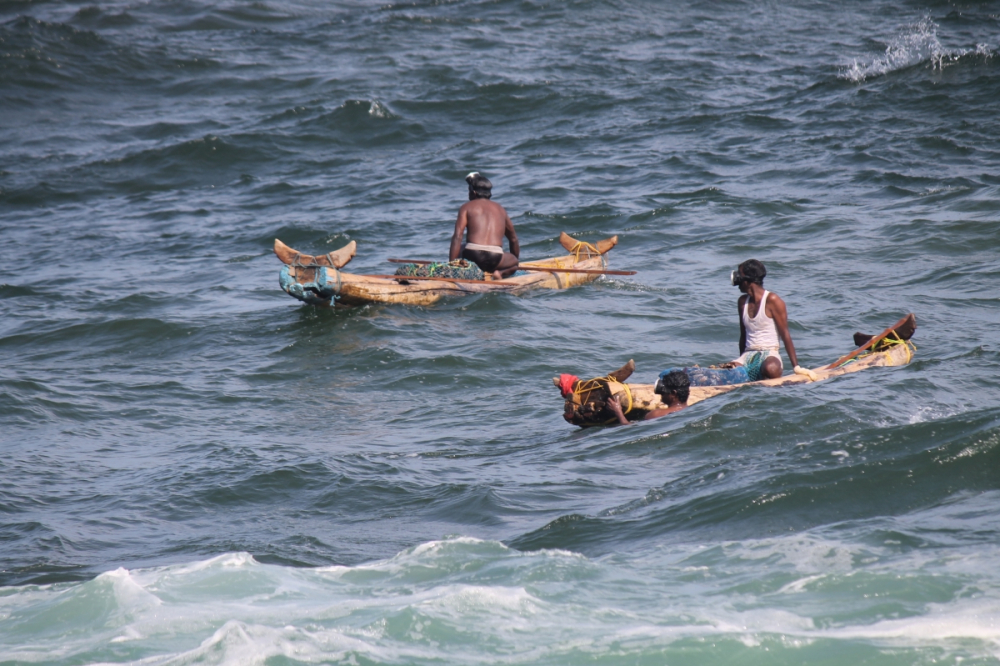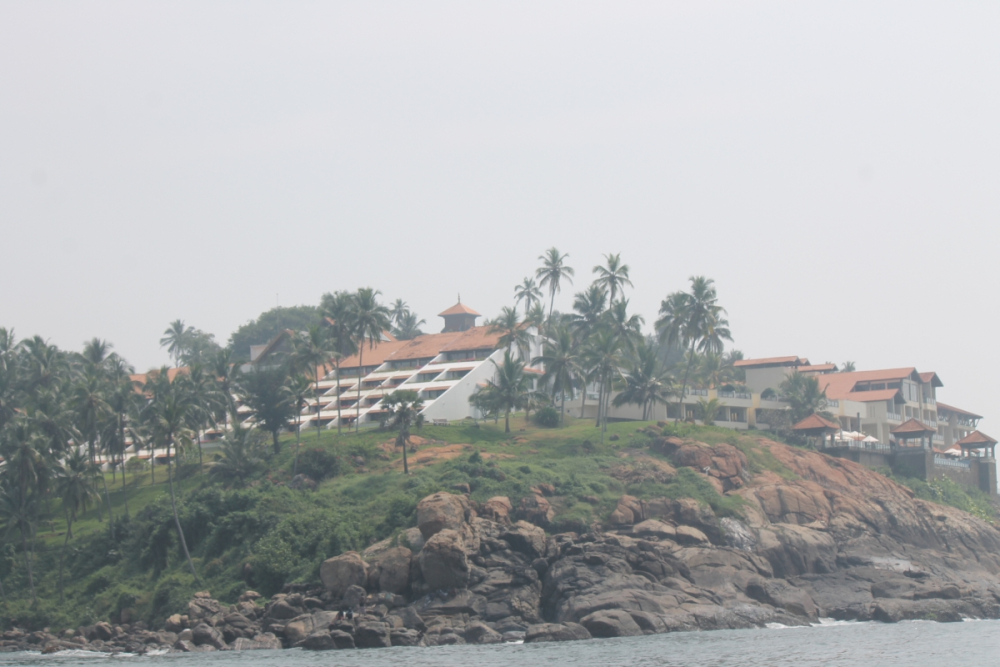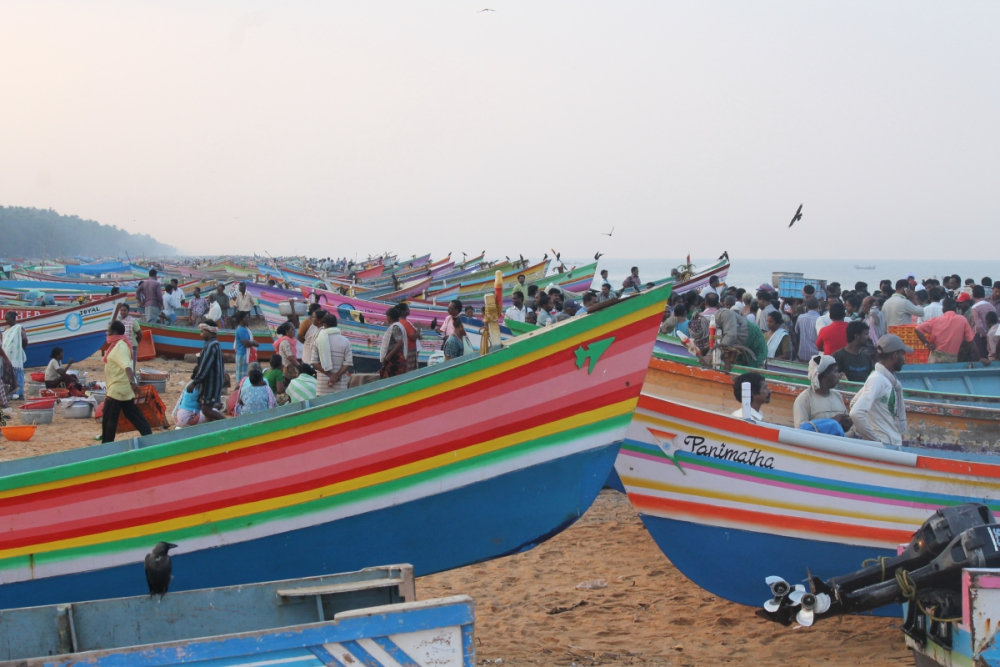An introduction to Thiruvananthapuram
The state of Kerala in the south-west of India has nine coastal districts. According to the Marine Fisheries Census 2010 by CMFRI (Central Marine Fisheries Research Institute), there are 222 marine fishing villages, with the maximum number (42) in Thiruvananthapuram district. The total number of fish landing centres is 187, of which 51 belong to Thiruvananthapuram. The state has approximately 1,18,937 fishermen households, with a population of 6,10,165, and the maximum number of families live in Thiruvananthapuram (33,340), which accounts for 24% of the total fisher population. Out of Kerala's fishermen households, 98% represent traditional fishermen, and about 46% of fisher folk are active fishermen. There are 54,407 fisher folk engaged in fishing-allied activities, such as marketing (38%), manual labour (27%), and others (35%). Thiruvananthapuram has the largest number of fisher folk engaged in fishing-allied activities (39%), and the majority of those involved in the marketing of fish also belong to the district (58%). Most fishing villages in the district have their basis in small-scale fisheries, which account for a large percentage of the state’s income.
Valiyathura

Valiyathura, a suburb of Thiruvananthapuram, is a marine fishing village. It was once the only port in the southern region of the erstwhile Travancore kingdom and the state of Kerala that was formed in 1956. For people in the city, Valiyathura is known more for the remnants of the pier that protrudes into the sea. Till the beginning of the 16th century, this place was known as Retora and later it became Raithura/Rajathura, meaning 'king's coast'. In the 18th century it came to be called Valiyathura ('big coast'). According to the travelogue of Barbosa, a 15th-century traveller from Portugal who stayed here for 15 years from 1515, 'the fishermen living in Retora are wealthy, having their own boats, and are living according to Christian beliefs.' The pier that survives is actually the one built in 1956 after the first one collapsed. The large number of godowns still seen in and around Valiyathura is a reminder of how active this port once was, catering to cargo steamers bringing in rice, salt, sugar, cement and other goods. Large numbers of manual labourers—many of them also otherwise fishers—would be involved in the unloading, as ships used to anchor a little away from the pier and fishing canoes were used to transport goods from the ships. But with the development of the Kochi port Valiathura ceased to be active. Once the port activities came to a standstill, the local fishers began to use the pier during the monsoon months to launch their kattamarams (catamarans) to bypass the rough waves that lash the coast. They would throw the kattamaram into the sea from the tip of the pier and follow it with a dive into the waters. As the kattamarams are replaced with plywood crafts fitted with outboard motors, this daring fishing practice too is very much on the decline.
According to the Marine Fisheries Census 2010, there are 2,069 fishermen families in Valiyathura, with 1,928 active fishers and 1,535 persons engaged in fishing-allied activities which includes 885 women fish vendors, the largest number in the district. The four-log kattamaram used to be the most important fishing craft in Valiyathura and in the district as well. They also used sails for propulsion. It was in the 1950s that hook-and-line fishing operations became more popular here with the migration of Tamil fishers from nearby Kanyakumari district, and they made use of natural reefs in the sea, together with traditional navigational methods to spot fishing grounds. According to a fishing fleet census done in 1991 (by SIFFS), Valiyathura was the leading village in the district with 1,230 kattamarams out of a total of 12,638. However, the 1998 SIFFS census shows the number of kattamarams decline dramatically to a mere 603 in Valiyathura and to 7,112 in the district. Today the number of kattamarams would be below 100. Conversely, between 1991 and 1998, the number of motorised craft increased from 56 to 66 in Valiyathura, and from 1,654 to 2,906 in the district. Shore seines, boat seines, various gill nets, and hook and line continue to be the major fishing gear used. The shore seines, used by the majority of fishers, including the elderly, have also gone down in number, maybe due to the loss of beaches and construction of sea walls all along the coast, which make their operation very difficult. In fact, the continuous erosion is a major worry for coastal dwellers in Valiyathura as many houses get destroyed or damaged and hundreds of families have shifted to temporary shelters like schools, especially during the monsoon season.
Kovalam
Kovalam is a small coastal tourist village. The flow of tourists from different countries to Kovalam is massive, especially during the tourist season. The main attraction here is the small sandy beach protected by rocky regions (promontories) forming a safe bay where people can swim and snorkel and enjoy the underwater biodiversity. There are 60 fishermen families resident at Kovalam and all are tradition fisher folk. The total fisher folk population reaches only 365, out of which 103 are active fisher folk. As the population of fishermen is very small, they make use of only 15 non-motorized crafts, mostly kattamaram.
As Kovalam is a rocky region, the fishers have adapted fishing practices that suit it. Indigenous livelihood practices contribute a high percentage to small-scale fisheries. Kovalam is one of the areas in Thiruvananthapuram where a vast area is covered with mussels, and so collecting these is the dominant practice. Most local fishermen are involved in mussel collection during the season. Other fishery practices in Kovalam are reef fishing, trap fishing, chunk collection and harpoon fishing, but for all these activities the fishermen use kattamarams.
Indigenous livelihood practices in Kovalam
The fishing practices in Kovalam are purely indigenous and evolved from the fishing community in accordance with the fishery resources they have. They are discussed below in detail.
1. Mussel Collection

Brown mussel (Perna perna) and green mussel (Perna viridis) are the two species of mussel collected by fishermen. These mussels attach themselves to underwater rocks at a depth of around seven metres. The fisherman scrapes out the mussels using a sharp tool and collects them in a net bag tied round his waist. There are women vendors waiting to sell off the catch as soon as it reaches the shore.
2. Trap fishing
This method is mainly used to catch lobsters by trapping them in a cage designed in such a way that the lobster can easily enter but cannot escape. The trap is made out of the dried stalk of coconut-palm leaf, so it is eco-friendly and can be used for a long time without damaging the underwater ecosystem. Once the trap is ready, the fishermen search for a suitable location to place it, i.e., depending on the availability of lobsters, and to ensure the trap is not dragged along with the current They usually secure the traps in gaps between rocks under the water. Once the lobsters are caught, the traps are withdrawn and the catch is taken ashore in the vessel.
3. Harpoon/Gun fishing
It is an ancient fishing practice where fish are pierced and caught using sharp tools similar to harpoons. In Kovalam the fishermen use modern equipment, a gun with a sharp metal harpoon attached to it which will pierce through the fish when the gun is shot. It is usually large species of fish like grouper, parrot fish, jack fish, snappers and surgeon fish which are collected using this method.
4. Chunk fishing
Toad rock shell (thais bufo) is the only variety of univalve which are collected by fishermen. The operculum (the hard covering which closes the mouth of the shell) is of high medicinal value, hence these shells are collected on a large scale.
Vizhinjam
Vizhinjam is known for its large harbour which can accommodate more than 100 boats at a time. It is divided into north and south, with Christian (3,054) and Muslim (1,050) majorities respectively. There are about 4,110 fishermen families residing at Vizhinjam and all are artisanal fisher folk. The total fisher-folk population is about 17,455, of which 4445 are active and only 667 are involved in fishing-allied activities. About 268 women are occupied as fish vendors. Eleven mechanized boats, 53 outboard and 31 non-motorized crafts are owned by fishermen in Vizhinjam.
In north Vizhinjam fishermen go for mussel collection and oyster cultivation for the CMFRI regional institution located in Vizhinjam. They also use bottom nets to harvest flat fish and flounders from the sea bottom. These bottom nets are operated at specific depths, and are mainly used on the muddy sea bed where flat fish are found. Once the net is laid out on the sea bed, it is left for a period before being retrieved to collect the fish. South Vizhinjam is mostly the harbour area and fishermen are involved in fishing, auctioning, fish processing and marketing. The other fishing methods are deep sea fishing, long-line tuna fishing, hook-and-line fishing and thangal fishing (where fishermen stay at sea for longer periods) and night fishing. Any catch in the boats is auctioned and marketed at the fish-landing centre itself. It is mainly women who are involved in fish processing and marketing. The most important craft used in Vizhinjam are OBM boats, plywood boats, large vessels for night fishing and deep-sea fishing etc. In the rough season most beaches will be eroded, hence the fishermen from different villages go to Vizhinjam harbour and launch their craft, because even in rough seasons the harbour is safe for both launching and landing.
Due to the ongoing dredging for the Vizhinjam international sea port, there is a collapse of the underwater natural habitats on which the fishermen depended for their daily sustenance, and this human activity threatens the lives of marine organisms as well as fishermen.
Mariyanadu
About 794 fishermen households reside in the fishing village of Marianadu. The total fisher-folk population is 3,628, of which 1,011 are active fisher folk, and 236 are involved in fishing allied activities. About 227 women are fish vendors. Fifty-three outboard and 60 non-motorized crafts are owned by Mariyanadu fishermen.
Most fishermen in Mariyanadu are reef fishers who are skilled at finding the fishing grounds in the sea bed. Hook-and-line is the major gear they use to catch fish from reefs. A few fishermen are involved in flounder fishing which commands a good export price. They use bottom nets for this purpose. But this kind of fishing is destructive as the bottom net also scoops up other molluscs and crustaceans along with flat fish and flounders. Light fishing during night is also slowly spreading as a trend because of the good catch possible. Nowadays fishermen are taking up novel techniques like using fluorescent lamps which emit high-intensity light which in turn attracts more fish to the boat to be scooped out.
During the rough season, huge waves surge towards the shore and the fishermen are compelled to launch their craft by breaking the roaring waves at huge risk to their lives. This adventurous launching sometimes meets with success after many trials which may last for hours. The fishermen usually lose their gear. Kattamarams and OBM boats are launched in such a manner. And all these can only be done by skilled and experienced fishermen who know the heartbeats of the ‘mother sea’.
|
Major fishing gears and species caught in Trivandrum |
|||
|
S. No |
Gears |
Marine species caught |
|
|
1 |
Hook and Line |
Common name |
Scientific name |
|
African Pompano |
Alectis ciliaris |
||
|
Shrimp Cad |
Alepes djedaba |
||
|
Yellow-tail scad |
Atule mate |
||
|
Blue revally |
Carangoides ferdau |
||
|
Yellow spotted trevally |
Carangoides fulvoguttatus |
||
|
Malabar Trevally |
Carangoides malabaricus |
||
|
Tomato Hond |
Cephalopholis sonnerati |
||
|
Brown spotted Grouper |
Epinephelus chlorostigma |
||
|
Brown-marbled Grouper |
Epinephelus fuscoguttatus |
||
|
Great Barracuda |
Sphyraena barracuda |
||
|
Bullet Tuna |
Auxis rochei |
||
|
Black tail Snapper |
Lutjanus fulvus |
||
|
2 |
Shore-seine |
Indian Scad |
Decapterus russelli |
|
Moron fish |
Mene maculata |
||
|
Yellowstrip Barracuda |
Sphyraena chrysotaenia |
||
|
Small-head ribbon fish |
Eupleurogrammus muticus |
||
|
Coomerson's Anchovy |
Stolephorus commersonnii |
||
|
Indian Anchovy |
Stolephorus indicus |
||
|
Spottyface Anchovy |
Stolephorus waitei |
||
|
Indian Oil sardine |
Sardinella gibbosa |
||
|
Spotted Sardinella |
Ambligaster sirm |
||
|
3 |
Long-liner |
Kawa Kawa |
Euthynnus affinis |
|
Skipjack Tuna |
Katsuwonus pelamis |
||
|
Yellow-fin Tuna |
Thunnus albacares |
||
|
Indian Mackerel |
Rasterlliger kanagurta |
||
|
4 |
Gill net |
Flounder |
Bothus myriaster |
|
Flounder |
Bothus pantherinus |
||
|
Flounder |
Pseudorhombus javanicus |
||
|
Gold-spot mullet |
Liza parsia |
||
|
Tade-grey Mullet |
Liza tade |
||
|
Flat-head Mullet |
Mugil cephalus |
||
|
Elongate surgeon fish |
Acanthurus mata |
||
|
Sword fish |
Xiphias gladius |
||
|
5 |
Traps |
Spiny Lobster |
Panulirus homarus |
|
Rock Lobster |
Panulirus ornatus |
||
|
6 |
Harpooning |
Tomato Hond |
Cephalopholis sonnerati |
|
Subnose Pompano |
Trochinotus blochii |
||
|
Balabar Blood Snapper |
Lutjanus malabaricus |
||
|
Emperor Red Snapper |
Lutjanus sebae |
||
|
Eclipse Parrot fish |
Scarus russelii |
||













